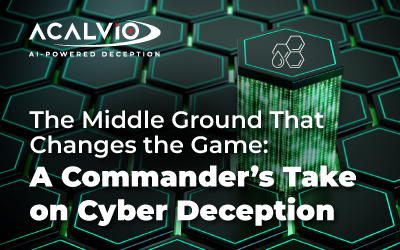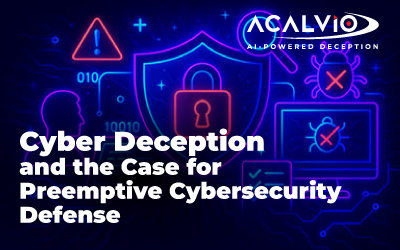
Until I discovered Acalvio, I was doing what most organizations still do today: build walls at the perimeter and prepare to recover when — not if — the adversary breaks through. Firewalls, phishing filters, endpoint protection, and a plan for resiliency. That was the playbook.
But there’s a critical piece missing from that sequence — a tactical middle ground that too many defenders overlook. It’s called deception. And it changes everything.
Deception Is Not a Trick — It’s a Strategy
In military operations, deception isn’t optional. It’s embedded into mission planning at every level. You don’t just defend your position — you mislead the adversary, force them to miscalculate, and position yourself to strike from a place of advantage.
Cybersecurity should be no different. But for years, defenders have focused entirely on building stronger walls or faster incident response, leaving the space in between — the moment of intrusion — unaddressed.
That’s where deception fits. It operates in the moment between breach and impact. And if implemented correctly, it ensures that the moment an attacker steps out of line, they are detected, diverted, and denied.
AI Gives Deception Teeth
Modern deception isn’t just about setting digital traps and hoping they work. With AI behind it, deception becomes intelligent, adaptive, and scalable.
Acalvio’s platform uses artificial intelligence to tailor deceptive assets to the environment — decoys that look, feel, and behave like the real thing. It lays out a minefield of false credentials, fake servers, and synthetic identities that are indistinguishable from production systems. Attackers have no idea they’ve taken the bait until it’s too late.
What happens next is where the real power lies. The moment deception is triggered, defenders gain visibility — not theoretical alerts, but high-confidence signals. You know where the attacker is, how they got there, and what they’re after. From there, you can monitor, contain, engage — and more importantly, prevent damage.
The Adversary Doesn’t Get a Free Run Anymore
Too often, when a threat actor gets inside a network, they’re operating unchallenged for days, even weeks. During that time, they’re mapping your infrastructure, stealing credentials, escalating privileges, and preparing to exfiltrate data or launch ransomware.
Deception puts an end to that. It breaks their confidence. It forces hesitation. It denies freedom of movement.
With deception in place, attackers can no longer assume the authenticity of what they see. Every system, every identity, every path forward could be a trap. And that uncertainty — that doubt — is exactly what defenders need to regain the upper hand.
Strategic Defense Is More Than Firewalls and Forensics
We’ve been conditioned to view cybersecurity in binary terms: keep them out, or clean up after they’ve gotten in. But this mindset ignores what military strategists have long known — success comes from shaping the battlefield before the first shot is fired.
Cyber deception reshapes the terrain. It gives defenders an active role even after perimeter controls are bypassed. And it aligns with what every seasoned commander knows: your enemy’s strength isn’t just in their weapons — it’s in their confidence. Deception strips that away.
This Deception Day, Reclaim the Initiative
Deception isn’t just another layer of defense. It’s the turning point. It’s where the defender stops reacting and starts maneuvering.
So this Deception Day, I challenge every security leader to take a hard look at their playbook. Are you still relying solely on prevention and recovery? Or are you prepared to operate in the middle — where the fight is won?
If you’re not using deception, you’re leaving critical ground undefended.



